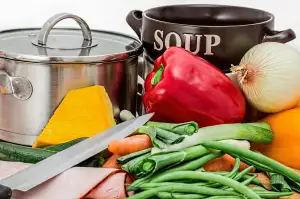Chicken Done Right: Discover the Perfect Internal Temperature for Safe and Delicious Poultry

Cooking chicken to perfection is an art that every home chef should master. Whether it's a succulent roast, a juicy grilled breast, or a tender piece of fried chicken, achieving the perfect internal temperature is crucial for both safety and taste. In this article, we will explore the importance of cooking chicken to the correct internal temperature and guide you through the various cooking methods and their respective temperatures. So let's dive in and discover the secrets to preparing safe and delicious poultry!
Importance of cooking chicken to the correct internal temperature
The importance of cooking chicken to the correct internal temperature cannot be overstated. It is crucial for both safety and taste reasons. Cooking chicken to the correct internal temperature ensures that any harmful bacteria, such as salmonella, are killed, making it safe for consumption. Additionally, cooking chicken to the correct temperature ensures that it is cooked through and juicy, resulting in a delicious and satisfying meal. Therefore, it is essential to know the recommended internal temperature for cooked chicken and how to achieve it through various cooking methods.
Recommended internal temperature for cooked chicken
The recommended internal temperature for cooked chicken is 165°F (74°C). This temperature ensures that any harmful bacteria, such as salmonella, are killed, making the chicken safe to eat. It also ensures that the chicken is fully cooked and tender, without being overcooked and dry. Using a meat thermometer is the most accurate way to determine if the chicken has reached this temperature.
Different cooking methods and their respective internal temperatures
Different cooking methods require different internal temperatures to ensure that chicken is cooked safely and deliciously. Here are the recommended internal temperatures for some popular cooking methods:
1. Roasting: When roasting a whole chicken, it is important to cook it until the thickest part of the thigh reaches an internal temperature of 165°F (74°C). This ensures that the meat is fully cooked and safe to eat.
2. Grilling: Grilled chicken should also reach an internal temperature of 165°F (74°C) in the thickest part of the meat. To achieve a juicy and flavorful result, sear the chicken over high heat first, then move it to indirect heat until it reaches the desired temperature.
3. Sautéing/Stir-frying: For sautéed or stir-fried chicken pieces, aim for an internal temperature of 165°F (74°C) as well. Cook them on medium-high heat until they are no longer pink in the center and juices run clear.
4. Deep-frying: Deep-fried chicken should have an internal temperature of 165°F (74°C) as well. Use a thermometer to monitor the oil temperature and ensure that all parts of the chicken are fully cooked.
Remember, these temperatures apply to both bone-in and boneless chicken. By following these guidelines, you can enjoy perfectly cooked chicken every time, with no risk of undercooking or overcooking.
Tips for ensuring chicken is cooked to the correct temperature
To ensure that chicken is cooked to the correct temperature, follow these tips:
- Use a meat thermometer: Invest in a good quality meat thermometer to accurately measure the internal temperature of the chicken. Insert the thermometer into the thickest part of the meat without touching bone for an accurate reading.
- Know the recommended temperatures: Familiarize yourself with the recommended internal temperatures for different cuts of chicken. This will help you determine when it is fully cooked and safe to eat.
- Allow for resting time: After removing chicken from heat, let it rest for a few minutes before cutting into it. This allows the juices to redistribute and ensures a moist and flavorful result.
- Adjust cooking times for different methods: Different cooking methods require different cooking times. Whether you're grilling, baking, or frying chicken, be mindful of adjusting your cooking time accordingly to reach the correct internal temperature.
- Cut thicker pieces into smaller portions: If you have thick pieces of chicken that are taking longer to cook through, consider cutting them into smaller portions. This will help ensure that they cook evenly and reach the desired internal temperature.
By following these tips, you can confidently cook chicken to its perfect internal temperature, ensuring both safety and deliciousness in every bite.
Common misconceptions about chicken doneness
There are several common misconceptions when it comes to determining if chicken is cooked thoroughly. One of the most prevalent myths is that you can judge the doneness of chicken by its color. Many people believe that once the meat turns white, it is fully cooked. However, this is not always the case.
Another misconception is that cooking chicken until it is dry ensures it is safe to eat. While overcooking chicken may eliminate any potential bacteria, it also results in a tough and tasteless meal. It's important to remember that achieving a safe internal temperature does not mean sacrificing flavor and juiciness.
Some individuals also rely on cooking time as an indicator of doneness. They assume that if they cook the chicken for a certain amount of time, it will be cooked through. However, factors such as oven temperature and thickness of the meat can greatly affect cooking times, making this method unreliable.
Lastly, some people mistakenly believe that marinating or brining chicken will guarantee its safety and doneness. While marinating can enhance flavor and tenderness, it does not guarantee that the internal temperature has reached a safe level.
To ensure your chicken is properly cooked, it's crucial to use a reliable meat thermometer and follow recommended internal temperatures rather than relying on visual cues or cooking times alone. By debunking these misconceptions and understanding the importance of reaching the correct internal temperature, you can confidently prepare delicious and safe poultry dishes every time.
In conclusion, cooking chicken to the correct internal temperature is crucial for both safety and taste. By ensuring that chicken reaches the recommended internal temperature, you can eliminate any potential risks of foodborne illnesses while also enjoying tender and juicy poultry. Remember to use a meat thermometer to accurately measure the internal temperature, and adjust cooking times accordingly based on the chosen method. With these guidelines in mind, you can confidently prepare delicious chicken dishes that are both safe and satisfying. Happy cooking!
Published: 26. 11. 2023
Category: Food



